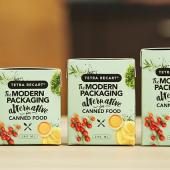It’s easy to say ink
In addition to printing products... The future today seems to lie in the innovative solutions developed by Sun Chemical to give value to packaging. But you can bet on it, this is just the beginning of a change that is not only technological but cultural, that will affect converters and brand owners. Stefano Lavorini
Indeed rivers of ink have been made to flow on the subject. Yet for many the old and simplistic classification that only distinguishes between writing and printing products, whether fat or heat based, still holds true. True indeed, but technology shows itself capable of changing the references by offering new, amazing solutions that can make packaging and consumer interaction more engaging, perhaps offering greater protection also in regard to the provenance and authenticity of the product.
We had a sample of this at the technical update seminar organized by Sun Chemical, which this year took place in Viareggio October 4 and 5: a training moment as always characterized by the intelligent choice of topics and the preparation and experience of the speakers, the technical directors Paolo Caiani for the sheet, UV and silkscreen division, and Egidio Scotini for the liquid inks section, not to mention the perfect organization.
Dedicated to "Interactive Packaging and Brand Protection", the meeting provided a state-of-the-art picture of the potential of printed packaging between an advanced marketing tool - combining identification, brand and logistics promotion - and a medium indispensable for combatting the phenomenon of counterfeiting. A plague that leads to a loss of 125 billion dollars* every year, covering all sectors, from electronics to tobacco, food to pharmaceuticals.
Below we try and put the many proposals into some kind of order.
To each customer their product
Over time, the evolution of marketing has shifted its focus from the product to the purchaser: the most important thing for a business is therefore to "create the customer". From this point of view, it is clear how technological interfaces can make interactions more engaging. The people at Sun Chemical have striven to underline this: by exploiting new technologies, packaging is in fact evermore destined to become a fundamental marketing vehicle as it is able to establish a direct relationship between consumer and brand owner.
The way ahead is that of the printing of electronic systems, which is finding new applications in the production of various components, from displays to sensors, from logical systems such as RFID tags and temperature indicators to smart packaging.
Labels, powered by external batteries, that light up in reaction to music or that use electroluminescent inks, are already here. With the progress of technology, and hence the conception of thin organic type batteries, truly innovative stand-alone products can be created.
For those who have the "courage" to try their hand in this field, silver and graphite based conductive serigraphic and flexo inks as well as UV dielectric inks are now readily available.
At the moment the new frontier is represented by the Touchcode™ application, marketed by T + Sun, a partnership between Sun Chemical and T + Ink, where the former provides the inks and the latter owns the technology.
Touchcode™ uses printed conductors to allow a card, which will soon be a piece of packaging (rigid or at least flat), to interact with a touchscreen device, smartphone or tablet, or that is to relate the world of print to that of Internet.
In practice, by using a special App and positioning the Touchcode™ card on the screen, keeping it in the connection zone, the content accesses are enabled. It has countless applications: product verification, online shopping, offers, surveys, but also interactive games.
Flexography and rotogravure are the printing processes that can be used by this system, obviously with different types of inks.
Trademark and product safety
Brand protection is another thing, in relation to which Sun Chemical proposes a multilevel approach based on the combination of three types of solutions: overt ones, where the security system does not need any instrumentation to be detected, and "machine readable" ones that need a non-specific hidden/detectable detector or that require a specially calibrated hidden/detectable detector for the solution.
The first group includes SunShift inks based on iridescent pigments that, depending on the viewing angle, give a different color to the image: These products, that can be water, solvent or UV based, can be used with flexo and screenprintt technology. But metacromic inks, mainly for silkscreen, that change color according to the light source, and thermochromic ones, which change color according to the temperature, can also be used.
The second group consists of SunGuard inks that require external devices to detect their presence.
Among the possible solutions, the combination of two different types of IR responsive inks, Orion and Apollo, that act as taggants inside the print and that can be detected by special detectors.
Another option is a special ink that can be used with all printing technologies, combined with a simple lens, with a special light source inside: the device can identify a series of otherwise invisible colored spots in a normal print.
The black invisible infra-red ink, Reveal, is also part of the same series: structured as a traditional ink, is available for all print technologies, can be printed on any media but disappears if viewed through an IR camera, thus attesting the authenticity of the packaging and content.
UV fluorescent inks, which have recently been enriched with new white and orange shades, complete the list.
For the truly demanding, moving onto the third group of security systems, Sun Chemical proposes the SunLock range, including Verigard, based on a calibrated detector able to detect the unique signal created by combining taggants in the ink (especially designed for the single product).
Microtag follows the same philosophy, offering a solution that works on magnetic resonance and which enables the authentication of a unique signal from a distance of 1 or 2 centimetres: especially useful in the case of packaged electronic components.
But that's not all. For very specific cases microspheres can be added to the product in such small amounts that only specialized laboratories following appropriate procedures can detect them.
And as if that were not enough... we go on to the prepress files
Security systems are not confined to the use of different types of specialty inks, but they can also entail targeted interventions on prepress files, with the aim of introducing small alterations capable of frustrating any attempt to replicate the original.
To offer a full service, Sun Chemical has signed an exclusive deal in the graphic arts field with the American company DSS-Document Security Systems for the provision of anti-counterfeiting systems based on the processing of graphics files.
By following this route, with Secur Print Technology, microelements can be made to appear as squares, distinguishable if magnified: copies and scans make them lose their corners, causing distortion. With Barcode Barricade in turn an extremely readable code can be created in the original, while the copies are not readable. With Phantom Technology, which cannot be replicated, invisible images can be included that can be viewed without special instruments, by merely tilting the print.
The modification of the graphics file not only prevents copies being made, but enables the originality of the product to be detected with a smartphone.
Thanks to the Authentiguard application, the DSS code printed on the packaging, label or document is simple to authenticate. The App can be used by both inspectors and consumers, and the Cloud archive allows full control of the same.
Last but not least one has PrismViewer, the next generation of "latent images" technology. The DSS hides the patented Prism image in the artwork. The Prism image prevents counterfeiting via copiers, scanners and high resolution photography. The latent image is only detected through the DSS PrismViewer application or via the use of an optical filter.
* Source: Camera di commercio americana
RELATED ARTICLE
Navigating… between interactive packaging and brand protection
























